| Course | Dessert, Snack |
|---|---|
| Place of origin | Philippines |
| Region or state | Ifugao |
| Serving temperature | Warm, room temperature |
Binakle is a type of steamed rice cake originating from the Ifugao province of the Philippines. It is made from glutinous rice (diket) that is pounded into a paste, wrapped in banana or rattan leaves, and steamed. Variants may also add sesame seeds or sweet potato. They are popularly eaten on special occasions or as a snack. Uncooked binakle, along with rice wine (baya), are common offerings to the bulul ancestor spirits in Ifugao rituals. [1] [2] [3] [4]

Ifugao, officially the Province of Ifugao, is a landlocked province of the Philippines in the Cordillera Administrative Region in Luzon. Its capital is Lagawe and it borders Benguet to the west, Mountain Province to the north, Isabela to the east, and Nueva Vizcaya to the south.

Pilaf or pilau is a rice dish, or in some regions, a wheat dish, whose recipe usually involves cooking in stock or broth, adding spices, and other ingredients such as vegetables or meat, and employing some technique for achieving cooked grains that do not adhere to each other.

The indigenous peoples of the Cordillera Mountain Range of northern Luzon, Philippines, often referred to by the exonym Igorot people, or more recently, as the Cordilleran peoples, are an ethnic group composed of nine main ethnolinguistic groups whose domains are in the Cordillera Mountain Range, altogether numbering about 1.5 million people in the early 21st century.

A national dish is a culinary dish that is strongly associated with a particular country. A dish can be considered a national dish for a variety of reasons:

The history of sushi began with paddy fields, where fish was fermented with vinegar, salt and rice, after which the rice was discarded. The earliest form of the dish, today referred to as narezushi, was created in Japan around the Yayoi period. In the Muromachi period (1336–1573), people began to eat the rice as well as the fish. During the Edo period (1603–1867), vinegar rather than fermented rice began to be used. The dish has become a form of food strongly associated with Japanese culture.
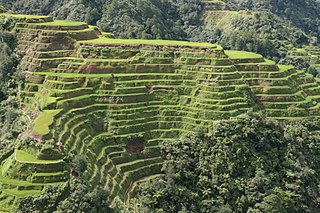
The Banaue Rice Terraces are terraces that were carved into the mountains of Banaue, Ifugao, in the Philippines, by the ancestors of the Igorot people. The terraces are occasionally called the "Eighth Wonder of the World". It is commonly thought that the terraces were built with minimal equipment, largely by hand. The terraces are located approximately 1,500 meters above sea level. These are fed by an ancient irrigation system from the rainforests above the terraces. It is said that if the steps were put end to end, it would encircle half of the globe.

Filipino cuisine is composed of the cuisines of more than a hundred distinct ethnolinguistic groups found throughout the Philippine archipelago. A majority of mainstream Filipino dishes that compose Filipino cuisine are from the food traditions of various ethnolinguistic groups and tribes of the archipelago, including the Ilocano, Pangasinan, Kapampangan, Tagalog, Bicolano, Visayan, Chavacano and Maranao ethnolinguistic groups. The dishes associated with these groups evolved over the centuries from a largely indigenous base shared with maritime Southeast Asia with varied influences from Chinese, Spanish and American cuisines, in line with the major waves of influence that had enriched the cultures of the archipelago and adapted using indigenous ingredients to meet local preferences.
Flattened rice is a type of rice dish made from raw, toasted, or parboiled rice grains pounded into flat flakes. They are eaten as is, toasted, fried, or used as ingredients or toppings for other dishes. Depending on their use, they can be crispy, crunchy, chewy, or soft in texture with a light nutty flavor. They are traditional to many rice-cultivating cultures in Southeast Asia and South Asia. It is also known variously as rice flakes, beaten rice, pounded rice, pressed rice or chipped rice.

The Rice Terraces of the Philippine Cordilleras are a World Heritage Site consisting of a complex of rice terraces on the island of Luzon in the Philippines. They were inscribed on the UNESCO World Heritage List in 1995, the first-ever property to be included in the cultural landscape category of the World Heritage List. This inscription has five sites: the Batad Rice Terraces and Bangaan Rice Terraces, Mayoyao Rice Terraces, Hungduan Rice Terraces and Nagacadan Rice Terraces, all in Ifugao Province. The Ifugao Rice Terraces reach a higher altitude and were built on steeper slopes than many other terraces. The Ifugao complex of stone or mud walls and the careful carving of the natural contours of hills and mountains to make terraced pond fields, coupled with the development of intricate irrigation systems, harvesting water from the forests of the mountain tops, and an elaborate farming system.

A rice cake may be any kind of food item made from rice that has been shaped, condensed, or otherwise combined into a single object. A wide variety of rice cakes exist in many different cultures in which rice is eaten and are particularly prevalent in Korea and Japan. Common variations include cakes made with rice flour, those made from ground rice, and those made from whole grains of rice compressed together or combined with some other binding substance.

Jollof, or jollofrice, is a rice dish from West Africa. The dish is typically made with long-grain rice, tomatoes, chilies, onions, spices, and sometimes other vegetables and/or meat in a single pot, although its ingredients and preparation methods vary across different regions. The dish's origins trace to the Senegambian region.
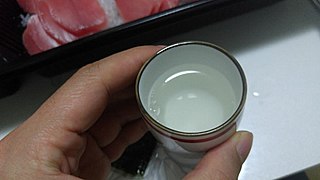
Cheongju, sometimes romanized as Chungju, is a clear, refined rice wine of Korean origin.

Tapai is a traditional fermented preparation of rice or other starchy foods, and is found throughout much of Southeast Asia, especially in Austronesian cultures, and parts of East Asia. It refers to both the alcoholic paste and the alcoholic beverage derived from it. It has a sweet or sour taste and can be eaten as is, as ingredients for traditional recipes, or fermented further to make rice wine. Tapai is traditionally made with white rice or glutinous rice, but can also be made from a variety of carbohydrate sources, including cassava and potatoes. Fermentation is performed by a variety of moulds including Aspergillus oryzae, Rhizopus oryzae, Amylomyces rouxii or Mucor species, and yeasts including Saccharomyces cerevisiae, and Saccharomycopsis fibuliger, Endomycopsis burtonii and others, along with bacteria.

Puto is a Filipino steamed rice cake, traditionally made from slightly fermented rice dough (galapong). It is eaten as is or as an accompaniment to a number of savoury dishes. Puto is also an umbrella term for various kinds of indigenous steamed cakes, including those made without rice. It is a sub-type of kakanin.
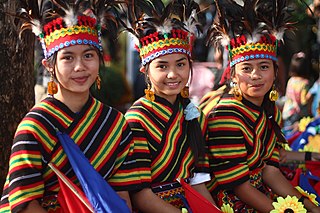
The Ifugao people are the ethnic group inhabiting Ifugao province in the Philippines. They reside in the municipalities of Lagawe, Aguinaldo, Alfonso Lista, Asipulo, Banaue, Hingyon, Hungduan, Kiangan, Lamut, Mayoyao, and Tinoc. The province is one of the smallest provinces in the Philippines with an area of only 251,778 hectares, or about 0.8% of the total Philippine land area. As of 1995, the population of the Ifugaos was counted to be 131,635. Although the majority of them are still in Ifugao province, some of them have moved to Baguio, where they work as woodcarvers, and to other parts of the Cordillera Region.
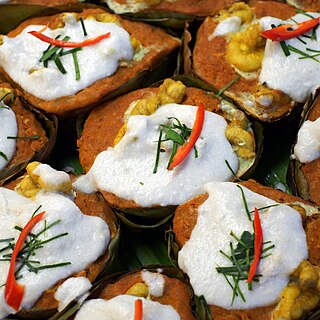
Steamed curry is a Southeast Asian type of curry steam-cooked in banana leaves and served with cooked rice. In Laos, it is also roasted on embers. The base of the curry is made with a curry paste with or without the addition of coconut cream or coconut milk and eggs. A wide range of leaves and staple ingredients are also added to the dish, such as:

Tapuy, also spelled tapuey or tapey, is a rice wine produced in the Philippines. It is a traditional beverage originated from Banaue and the Mountain Province, where it is used for important occasions such as weddings, rice harvesting ceremonies, fiestas and cultural fairs. It is produced from either pure glutinous rice or a combination of glutinous and non-glutinous rice together with onuad roots, ginger extract, and a powdered starter culture locally known as bubod. Tapuy is an Ilocano name. The wine is more commonly called baya or bayah in Igorot languages.

Puto bumbong is a Filipino purple rice cake steamed in bamboo tubes. It is traditionally sold during the Christmas season. It is a type of puto.
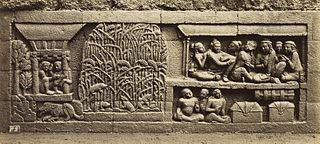
The history of rice cultivation is an interdisciplinary subject that studies archaeological and documentary evidence to explain how rice was first domesticated and cultivated by humans, the spread of cultivation to different regions of the planet, and the technological changes that have impacted cultivation over time.
Old Kiyyangan Village (OKV) is an archeological site in the Lazo highlands in the province of Ifugao in the Cordillera Administrative Region of the Philippines. The importance of this site is the presence of the Ifugao people and culture as the first inhabitants in the valley, who also represent one of the major indigenous Filipino societies for rice cultivation. This site is surrounded by rice terraces used for agricultural practices and remain heavily debated as to when and how recent these terraces formed. Artifacts found at this site suggest a strong influence of Christianity, mortuary rituals, and a system that defined social status according to the accumulation of various beads and ceramics.